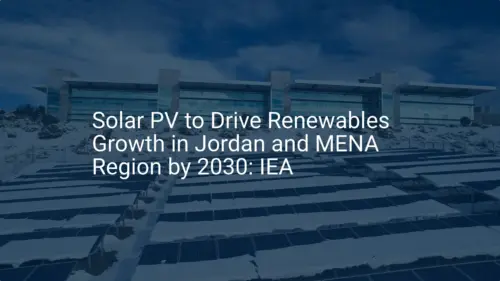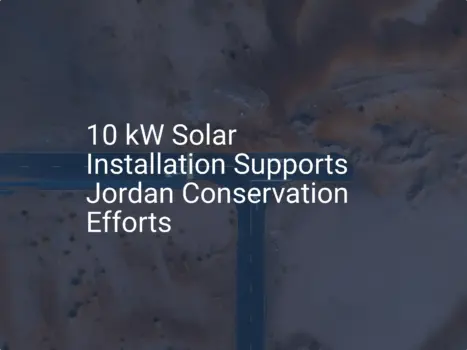For an investor seeking to establish a new solar module factory, Jordan stands out as a politically stable, strategically located hub. The country’s high solar irradiation and proximity to key markets in the MENA region and Europe create a compelling business case.
However, the initial decision of where to establish the facility within Jordan is critical to its long-term profitability. Choosing between the Ma’an Development Area, the Aqaba Special Economic Zone, or another designated area is more than a matter of real estate. This decision directly impacts fundamental cost drivers, from electricity tariffs to logistics and labor.
For an energy-intensive business like solar module manufacturing, the right choice can create a significant competitive advantage, while the wrong one can saddle the operation with uncompetitive costs from day one.
This analysis offers a business-focused comparison of Jordan’s primary economic zones, tailored to the specific needs of a solar production facility.
Understanding the Core Factors for a Solar Factory Location
Before comparing specific zones, it’s essential to understand the primary variables that influence a solar manufacturing plant’s success. While many factors contribute to the overall business plan, four pillars stand out in the site selection process:
-
Energy Costs: The solar module manufacturing process, particularly lamination and cell testing, is highly electricity-intensive. A favorable electricity tariff can be the single most significant factor in reducing the operational cost per module.
-
Logistics: A factory requires a steady inflow of raw materials (glass, cells, aluminum frames) and a smooth outflow of finished modules. Proximity and efficient connections to a major seaport like Aqaba are vital for managing supply chain costs and lead times.
-
Labor Availability and Cost: Access to a workforce with the appropriate technical skills is crucial. This includes technicians for operating machinery and engineers for process management. The local labor market determines not only wage costs but also the ease of recruitment.
-
Incentives and Taxation: Special economic zones offer benefits such as reduced corporate income tax, exemptions from customs duties on imported machinery and raw materials, and waivers on sales tax. The specifics of these incentive packages can heavily influence initial capital expenditure and ongoing profitability.
Evaluating each zone against these four pillars is the key to an informed strategic decision.
Ready to make big Profits?
The solar Industry is Booming
WE HELP NEWCOMERS to the solar industry start their own solar module production line. Customers can make BIG PROFITS by selling modules and finding investors, without wasting money and time on things they don't need!
Head-to-Head Comparison: Ma’an Development Area (MDA) vs. Aqaba Special Economic Zone (ASEZ)
For most prospective solar manufacturers in Jordan, the primary choice narrows down to two locations: the industrially focused Ma’an Development Area and the logistics-centric Aqaba Special Economic Zone.
The Decisive Factor: Energy Costs
The most significant operational difference between Ma’an and Aqaba for a solar factory is the cost of electricity.
The Ma’an Development Area was specifically designed as a hub for renewable energy and energy-intensive industries. To attract such investment, it offers a special, subsidized electricity tariff of JOD 0.075 per kilowatt-hour (kWh).
In contrast, a facility in the Aqaba Special Economic Zone (ASEZ) would pay the standard industrial electricity tariff, which is typically around JOD 0.12/kWh or higher, depending on consumption levels. This amounts to a cost increase of over 60% for a primary operational expense.
For a medium-sized factory, this difference in energy cost can translate into hundreds of thousands of dollars in savings annually, directly improving the production cost per watt and enhancing market competitiveness.
Logistics: Port Proximity vs. Total Landed Cost
ASEZ’s primary advantage is its location. As Jordan’s only coastal outlet, it contains the Port of Aqaba. This eliminates the need for domestic transportation for imports and exports, offering maximum simplicity for supply chain management.
Ma’an is located approximately 100 km northeast of Aqaba and is connected by a modern desert highway. While this adds a domestic transport leg to the logistics chain, many feasibility studies find that the substantial savings on electricity costs in Ma’an more than compensate for the modest increase in trucking expenses.
The analysis shifts from simple port proximity to calculating the total landed cost of a finished module, where Ma’an often emerges as the more financially viable option.
Tax Incentives and Labor Pool
Both MDA and ASEZ offer attractive incentive packages, featuring a flat 5% corporate income tax rate and exemptions from customs duties and sales taxes on imported raw materials, machinery, and finished exports. The fine print of these policies may differ slightly, but for a standard solar manufacturing setup, both offer a highly favorable fiscal environment.
Regarding labor, Aqaba has a larger and more diverse population. However, Ma’an holds a distinct advantage through its direct link with the Ma’an Vocational Training Center, which develops technical skills tailored to local industries. This makes it easier to recruit a trained, local workforce.
Assessing Other Potential Zones: KHBP and QIZs
While Ma’an and Aqaba are the primary contenders, two other types of zones warrant consideration for specific business models.
King Hussein Business Park (Amman): A Hub for Headquarters, Not Production
Located in the capital city of Amman, the King Hussein Business Park (KHBP) is a premier destination for information technology, BPO, and corporate headquarters. It offers access to the capital’s large, highly educated talent pool. However, with the highest commercial electricity rates in the country and its significant distance from the port, it is logistically and financially unsuitable for a manufacturing operation. A company might, however, choose to establish its factory in Ma’an and its administrative headquarters in Amman.
Qualified Industrial Zones (QIZs): The US Market Specialist
Jordan’s Qualified Industrial Zones were established under an agreement with the United States. Goods produced within a QIZ that meet certain criteria, including a minimum percentage of Israeli content, can enter the US market duty-free.
If the primary target market for the solar modules is the United States, establishing the factory in a QIZ could provide a powerful competitive edge by eliminating tariffs. For factories targeting markets in the MENA region, Europe, or Africa, however, this specific benefit doesn’t apply. Furthermore, QIZs operate on standard industrial electricity tariffs, making them operationally more expensive than Ma’an. The choice of a QIZ is therefore a strategic one, dictated entirely by the export destination.
Making the Final Decision: A Business-Centric Framework
The optimal location for a solar factory in Jordan is not a one-size-fits-all answer; it depends on the core priorities of the business model.
-
For Cost-Leadership in MENA/Europe: If the goal is to produce modules at the lowest possible cost per watt for regional and European markets, the Ma’an Development Area is the superior choice. Its unmatched electricity tariff provides a sustainable, long-term operational cost advantage that is difficult to overcome.
-
For US Market Access: If the business plan is centered on exporting to the United States and leveraging the U.S.-Jordan Free Trade Agreement, a Qualified Industrial Zone (QIZ) should be seriously evaluated, despite higher energy costs.
-
For a Logistics/Trading Focus: If the business model involves minimal manufacturing and more assembly or trading of finished solar components, the simplicity and logistical advantages of the Aqaba Special Economic Zone (ASEZ) may be compelling.
A detailed feasibility study is essential to validate these assumptions. Such a study models the complete investment requirements for a solar module factory, including capital costs for selecting the right production equipment and long-term operational expenditures, to create a clear financial projection for each location. Based on experience from multiple turnkey projects, this detailed financial modeling is the foundation of a successful site selection process.
Frequently Asked Questions (FAQ)
What makes solar manufacturing so energy-intensive?
The two most power-consuming stages are the lamination process, where the module’s layers are heated and fused together under pressure, and the continuous operation of the stringer machines and testing simulators (sun simulators). These processes run 24/7 in most facilities, leading to high, consistent electricity demand.
How difficult is it to import raw materials and export finished goods from Ma’an?
While Aqaba is at the port, the infrastructure connecting it to Ma’an is modern and efficient. The Desert Highway is a primary transport artery. Customs clearance procedures are well-established for all economic zones, allowing for a smooth flow of goods from the Port of Aqaba to a factory in Ma’an.
What kind of machinery is needed for a starter factory?
A typical semi-automated production line includes a cell stringer, bussing and layup stations, an electroluminescence (EL) tester, a laminator, a framing machine, and a final sun simulator for testing and classification. The specific configuration depends on the desired output capacity and level of automation.
Is it necessary to have a local partner in Jordan?
While not legally required to set up in a development or free zone, having a local partner or experienced consultant can be invaluable for navigating administrative processes, understanding the local business culture, and accelerating the setup phase. A turnkey solar factory solution often includes this level of on-the-ground support.
Conclusion: Your Next Steps in Planning
The choice of location within Jordan is a foundational decision that will influence a solar manufacturing project’s cost structure for years to come. While all of Jordan’s special economic zones offer an attractive fiscal environment, the Ma’an Development Area’s unique, low-cost energy tariff presents a compelling advantage for the power-intensive work of producing solar modules.
The logical next step for any serious investor is to move from this strategic overview to a detailed financial model. By quantifying the impact of energy costs, logistics, and labor on the final production cost per module, you can make a data-driven decision that aligns perfectly with your business’s objectives and target markets.








